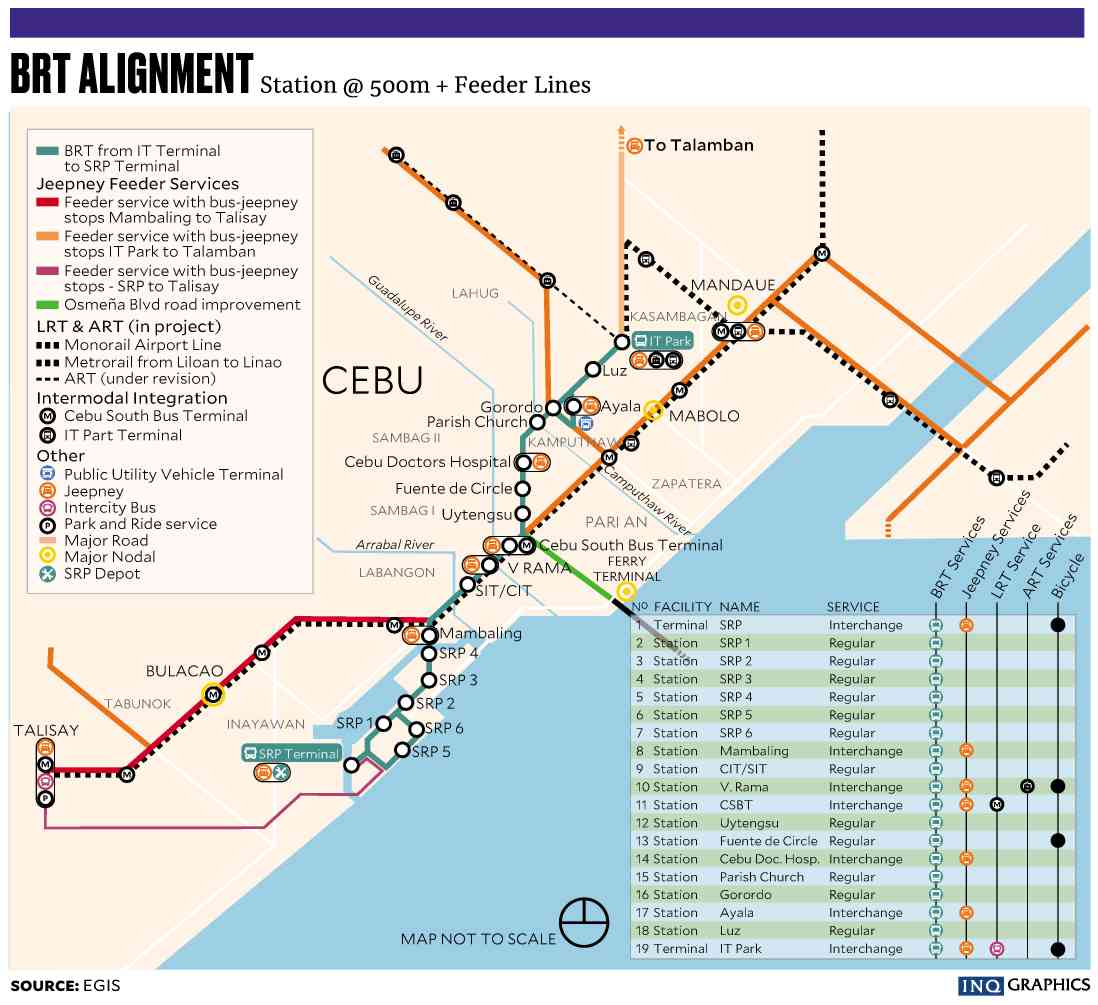
There is just an obstacle ahead—or rather, a narrow road ahead.
The city’s narrow roads forced the Department of Transportation (DOTr) to reduce the dedicated bus lanes under the P16.3-billion Bus Rapid Transit (BRT) system to only 13 kilometers from 23 km.
Transportation Undersecretary Mark de Leon clarified they were not shortening the route since the roads without dedicated lanes for buses would still be part of BRT as “feeder lines,” which meant the buses would have to share the roads with other vehicles.
If they were to include these feeder lines, De Leon said the entire stretch would even be 16.88-km longer since the entire BRT system would cover 39.88 km compared to the original plan of 23 km.
Reports of the “shortened” BRT route prompted project proponent, former Cebu City Mayor Tomas Osmeña, to write to the National Economic and Development Authority (Neda)-Investment Coordination Committee.
He asked the agencies to “assess these current changes” since these were different from the original BRT plan when it was first proposed in 2008 and later approved by the Neda board.
De Leon explained only 13 km—from the South Coastal Road in the south to the Cebu IT Park in Barangay Lahug in the north—could house the BRT system and where the roads were wide enough to accommodate dedicated bus lanes.
“That is the reality we have for our roads in Cebu … Napakasikip (The roads are very narrow),” De Leon said.
BRT buses would still pass through other city streets but would have to compete with other vehicles for the use of the roads, De Leon said in a recent news conference.
In the end, bus schedules might not be reliable after all since the buses could be stuck in traffic along with other vehicles using the cramped space.
Other plans
Modification was also needed to ensure the BRT system would complement other mass transport systems proposed for Cebu, De Leon explained.
Secretary Michael Dino, presidential assistant for the Visayas, said the BRT system would be part of the Cebu integrated intermodal transport system (CIITS) that would include a monorail system from the towns to the Mactan-Cebu International Airport in Lapu-Lapu City.
The CIITS would also include a cable car system from upland villages in Cebu City to the city proper.
Unlike the BRT, De Leon and Dino said these two systems were still open for “unsolicited proposals” for a public-private partnership similar to that of the Bulacan airport project in Luzon.
Feasible
The Cebu BRT project was initiated in 2008 by then Mayor Osmeña.
Although backed by a feasibility study prepared and commissioned by the World Bank in 2009, implementation was deferred pending a proof of concept that needed to be presented to the Neda board. Note that the BRT proposal was the first of its kind in the country then.
In April 2014, the Department of Transportation and Communications—before it was made to focus on transportation and became the DOTr of today—
presented the proof of concept to the Neda board.
The project was finally approved in May 2014. The project had a price tag of P10.6 billion.
In October 2014, a $116-million (about P6 billion) loan agreement was signed between the Philippines and the World Bank. The government would take care of the remaining amount.
In 2015, South Korea-based Kunhwa Engineering and Consulting Co. Ltd. was awarded the detailed engineering design and construction supervision contract.
The price tag ballooned to P16.3 billion as of June 2017 as acquisition of road right of way inflated costs. The amount was approved by the Neda board in September 2017.
The delays and other factors, among others, pushed Transportation Secretary Arthur Tugade and Secretary Dino to call for the cancellation of the project.
Thanks to calls from other stakeholders, the BRT project was retained and was made part of the CIITS proposed by the DOTr.
Victor Dato, World Bank task team leader, told Cebu City Mayor Edgar Labella during their meeting on Aug. 14, that the DOTr would be remobilizing Kunhwa Engineering and Consulting to finalize the engineering design for the BRT project.
“The DOTr is ready to reengage Kunhwa. In a few weeks, they will be ready to do final works on the detailed engineering design,” Dato told city officials.
After the completion of the detailed engineering, civil works should commence soon. —WITH A REPORT FROM DALE ISRAEL, INQUIRER VISAYAS